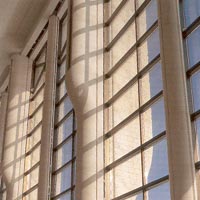










|

|

|

|

|

|

|

|

|

|
|

|
||||

|
|||||
|
|
||||

origins | career | technology | philosophy In 1963, he graduated with an Honours Bachelor of Architecture and returned to Canada, back to his old employer, Bissell and Holman, for a one-year apprentice. Following from that, he started his own architectural firm, Douglas J. Cardinal Architect, in Red Deer. At that time, he met Father Merx of St. Mary's Roman Catholic Church. Father Merx was intrigued by Cardinal's unique designs and approached him about reconstructing St. Mary's Church. Cardinal immediately surveyed the area and worked with Father Merx on possible designs. He wanted the building to evolve around the people and their activities that would be held within the church. His radical design of a curved building with a tent-like ceiling faced tremendous opposition from the church community and local building surveyors. They refused to believe his ceiling would hold and called the building an atrocity. Being a man of perseverance, he rented computer time from the University of Chicago to process the 81,000 equations required to construct the roof and entire building. He wanted the church to appear as if it had evolved from its present environment. In 1967, it was completed. In a world where right-angles were essential to town planning, and curved perimeters were associated with primitive architecture, Douglas Cardinal thus began to design buildings with sweeping top lines and curvilinear walls. Despite the many hurdles he face throughout the construction process, intuitively he knew the importance of this church to his career, and so he put much of his own resources towards the completion of it, to the point where it almost cost him his financial solvency. Notwithstanding, it was this commission that catapulted Cardinal's name as an architect of talent, imagination and ambition. "I'd say ninety eight percent of the parish was proud of what we'd done with St. Mary's Church when we had that first mass. It was soon a tourist attraction and I was forever running out of postcards." enthused Father Merx While Cardinal was designing and constructing St. Mary's Church, he also undertook other commissions. In subsequent buildings such as the Grande Prairie Regional College, the Ponoka Government Services Center and the Edmonton Space Sciences Center, his designs bear his signature trademark of undulating shells. By the late 1970s, he was beginning to establish a reputation as one of the most talented Organic Architects in North America. By the early 1980s, he was developing a reputation for his unique organic architecture marked by curvilinear lines and informed by Native culture. In 1983, Cardinal won the contract for what many believe is his greatest work - the Canadian Museum of Civilizations in Hull, Quebec. This commission exponentially drew public interest to his work, gaining him further recognition and awards throughout North America and around the world. He is proud of his work and the execution of his firm's processes of design. "The CMC conformed exactly to my architectural vision. The design process is key to our firm's success. This process involves designing the building from the inside out, based on the functional requirements of the employees who work within the space, and from the outside in, based upon the influence of the external environment. We involve the people who are in charge, and those who use the facilities in developing the vision. Their vision sets out their goals and aspirations, and their programs for carrying out those goals. This process involves consulting as many people as possible, through presentations and proposals and incorporating their ideas into a detailed analysis of the spaces that will house the people working within. The design is further refined from peoples' input, criticism, and feedback, until it meets the needs of everyone who has responsibility for the project." During the construction of this museum, Cardinal moved his firm, Douglas J. Cardinal Ltd. to Ottawa, Ontario. Today, the firm has an international standing, with a plethora of contracts. Currently, the architect, Bret Cardinal, manages the firm that his father created, continuing the architectural vision of the elder Cardinal. "The international work that we pursue are the types of projects that will make a contribution to peoples' lives, and to the environment within which they live and thrive - projects that are in harmony with our clients' culture, and which show respect for their natural environment." - Douglas Cardinal |
|||||
|
|
home | bio | showcase | design | interpretations | projects | awards | biblio |
|
|
|
||